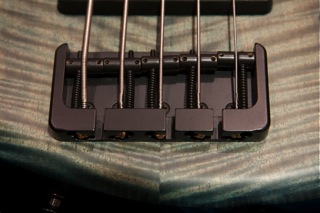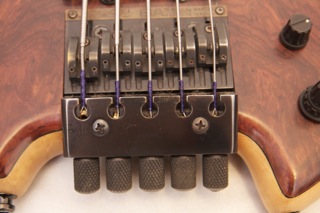Bass Bridges

I’m talking about the bit of the bass that keeps the strings on, not that funny bit of the song between the verse and the chorus. What we have here today, my fellow bass lovers, is a tale of three bridges.
It wasn’t until I saw a Badass bridge on a bass for the first time that I realised the importance of that lump of metal holding the strings on to the body. Leon Quan‘s metal marvel promised a new generation of bassists better sustain and tone, without a completely new bass. It was a huge leap ahead of the standard Jazz Bass bridge of the time, which was a wafer thin mint by today’s bass bridge standards. The first picture is of a model II on my Moses-necked Jazz bass (the one featured in “Graphite Bass“).

It isn’t just a matter of tone, some bridges can be practical too. The Style B Hipshot bridge, pictured on an MTD bass here, makes changing strings much simpler. Rather than having to thread them in and out of small holes, the strings simply unhook and can be lifted out through those slots. It makes for a much faster string change. Less chance of scratching the neck and body when taking the string on and off too. Very slick.
My main bass does involve threading strings through holes though, and there’s no way around it. Just as I was captivated by Leo Quan’s master piece, when I saw and heard a through-body strung bass, I knew it was the sound for me. The 5 string Elrick bass I play has a Hipshot bridge that allows for through body or normal stringing.

Lakland basses have their own variant on this idea, with a MusicMan style bridge. What you can’t see in this picture is the string ferrules on the other side of the bass where the strings are seated. The set up results (at least theoretically) in more down force on the bridge. It also means longer strings are required (back to the discussion on scale lengths).
So, that lump of metal can make quite a difference to your bass. Next time you are choosing an instrument, check out the bridge – it might be more important than you think.
 A post on bridges wouldn’t be complete without mentioning the ultimate evolution of bridge-art: The bridge of the headless bass. In a truly shark jumping manoeuver, this little innovation managed to displace the machine heads. The item here is from a near-vintage Sei bass.
A post on bridges wouldn’t be complete without mentioning the ultimate evolution of bridge-art: The bridge of the headless bass. In a truly shark jumping manoeuver, this little innovation managed to displace the machine heads. The item here is from a near-vintage Sei bass.
Common across all of these bridges are two other things which are essential for a good bridge:
- The ability to adjust the action (string height).
- Adjustment for intonation (shorten/lengthen the string length).
[…] at the bottom of the bass are the ferrules that enable the through-body stringing (mentioned in Bass Bridges). Looking at the bridge from the front you can see that the strings can go through the bridge in […]
Thanx! Interesting info. Would love to read a comparison of tones they all produce.
Another outstanding solution is individual bridge for each string. I wonder how it compares to conventional ones tone- and usability-wise
Hello Alexander! I’m working on that one – if I can get a string maker to provide the strings, I’ll video and record all the different sets.
On the individual bridge pieces, I have had that set up on one of my basses, although most of them have conventional bridges. It did seem to reduce the ringing of adjacent strings, but that might have been the bass rather than the bridge.